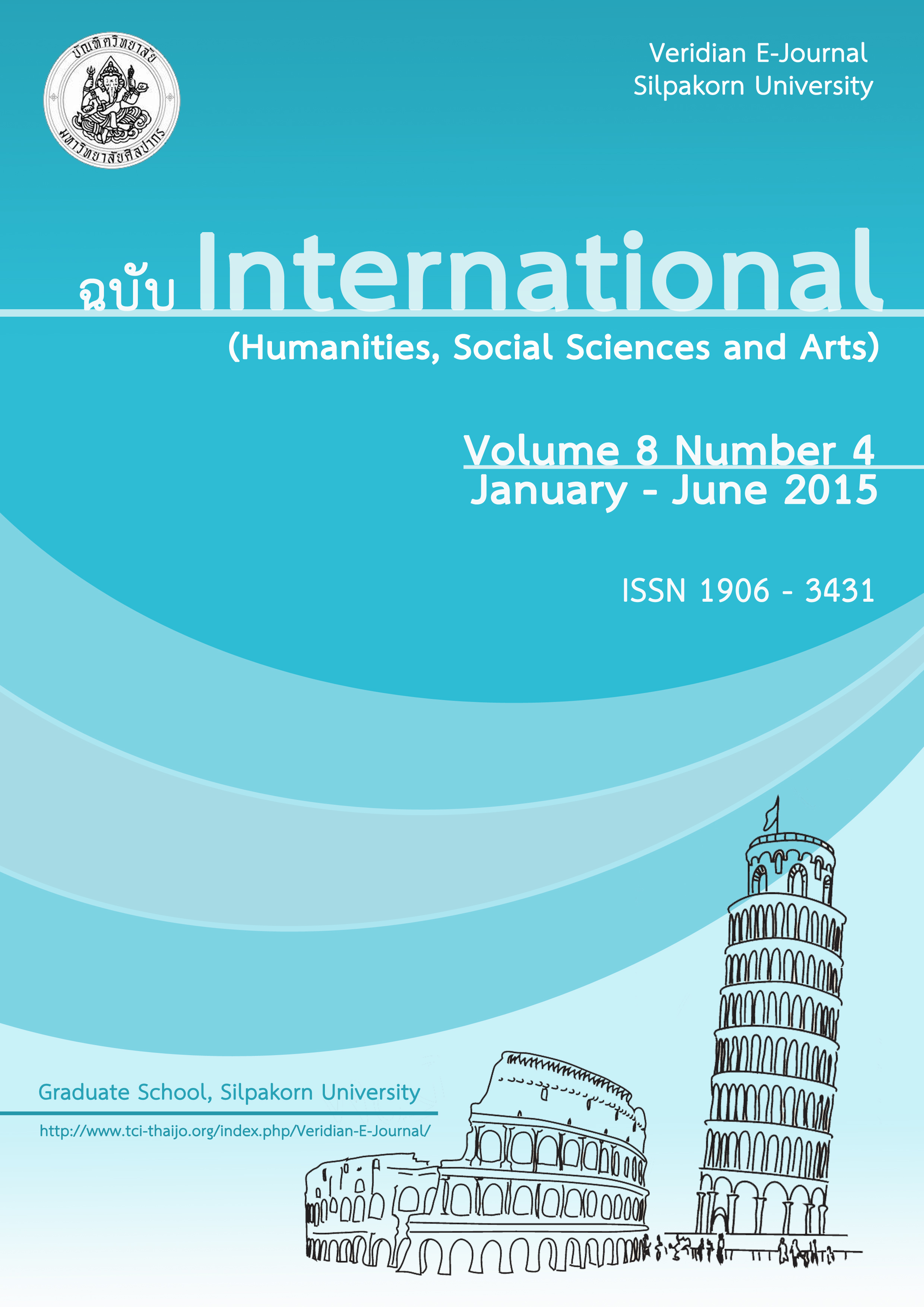Modular batik stamp block : Development of Southern Thai Printing batik stamp block
Main Article Content
Abstract
Abstract
According to the survey on block-printed batik production using metal blocks in Thailand’s three southernmost provinces – Pattani, Yala and Narathiwat, only batik factories in Narathiwat were found using such method. Since the blocks were made of metal, their parts were damaged by getting bent, twisted or hit by one another when stored. Additionally, the metal parts would come off the plates because they were not properly welded. According to Mr. Ya Bindorlao, a metal block-maker, batik block production and repair required meticulous skills and expertise. In addition, some blocks were repairable while others were discarded due to high repair cost although some parts were still functional. Batik makers, therefore, tended to use the same blocks repeatedly, limiting innovative patterns in the market.
The objectives of this study were as follows: 1) To collect and examine batik motifs on metal blocks in the three southernmost provinces of Thailand. 2) To develop modular batik blocks, whose parts can be removable and adjustable in order to create more patterns
The study shows that the motifs found on the metal blocks can be classified into six categories: 1) a flora motif, 2) a geometric motif, 3) a fauna motif, 4) an object motif, 5) a mixed flora and geometric motif and 6) an alphabet and symbol motif.
The modular batik blocks developed in this study are composed of 1) a plate, 2) metal motif parts, 3) wood motif parts and 4) a handle. To create patterns, users are able to choose to use either only metal, or only wood or a combination of both metal and wood motif parts to arrange on the plate. The experiments showed the following results:
1. The re-arrangement of motif parts resulted in the diversity of patterns.
2. The use of a mix of metal and wood parts only on one plate yielded more dimensional effects on line motifs on the fabric. In other words, metal parts gave thin line motifs while wood parts created thicker stripes, resulting in a unique appearance.
3. With the use of both metal and wood parts, when the blocks are submerged in hot wax, the amount of wax used needed to be reduced by shaking off the excess wax. However, how much wax should be shaken off depended on the concentration of the wax solution.
Keywords: Batik stamp, block-printed batik
บทคัดย่อ
การทำผ้าบาติกลายพิมพ์ด้วยแม่พิมพ์โลหะในประเทศไทยนั้น จากการสำรวจพื้นที่ในเขต สามจังหวัดชายแดนภาคใต้ คือ จังหวัด ปัตตานี ยะลา และนราธิวาส พบว่า มีโรงงานผลิตผ้าบาติกในเขต จังหวัดนราธิวาส และเนื่องจากวัสดุที่ใช้ในการทำพิมพ์เป็นโลหะ จึงมีการยุบตัวของชิ้นโลหะที่นำมา ประกอบ เป็นแม่พิมพ์อันนื่องมาจากการกระแทก ของแม่พิมพ์กับวัตถุอื่น หรือแม่พิมพ์ชิ้นอื่นใน ขั้นตอน การจัดเก็บ อีกทั้งยังมีการหลุดของชิ้นส่วนโลหะที่นำมาประกอบ เป็นลวดลายบนแม่พิมพ์ อันเนื่องจาก โลหะบัดกรี ไม่ยึดตึดติดกับโลหะที่นำมาประกอบเป็นลวดลายบนแม่พิมพ์ ซึ่งนายยา บินดอเลาะห์ ช่างทำแม่พิมพ์ผ้าบาติกชาวไทย ได้กล่าวไว้ว่า การทำและซ่อมแซมแม่พิมพ์ ต้องใช้ความประณีต และความชำนาญ แม่พิมพ์บางชิ้น สามารถซ่อมแซมได้ แต่อีกหลายชิ้นต้องทิ้งไปเพราะไม่สามารถซ่อมได้ ถึงแม้จะมีบางส่วนบนแม่พิมพ์ที่ยังใช้งานได้อยู่ และเนื่องจากราคาในการทำและซ่อมแซม แม่พิมพ์ แต่ละชิ้นมีราคาที่ค่อนข้างสูง ผู้ผลิตผ้าบาติกลายพิมพ์จึงนิยมใช้แม่พิมพ์วนไปเรื่อยๆ เราจึงไม่ค่อยเห็น ผ้าบาติกลายพิมพ์ที่มีลวดลายแปลกใหม่ในท้องตลาด
การทำวิจัยในครั้งนี้ผู้วิจัยมีจุดประสงค์ดังนี้ 1) รวบรวมและศึกษาลวดลายผ้าบาติกที่อยู่บน แม่พิมพ์โลหะในเขต 3 จังหวัดชายแดนภาคใต้ 2) พัฒนาแม่พิมพ์ผ้าบาติกแบบโมดูลาร์ ที่สามารถปรับ เปลี่ยนชิ้นส่วนลวดลาย และสามารถปรับเป็นลวดลายใหม่ได้หลายรูปแบบ
จากการศึกษาและรวบรวมข้อมูลลวดลายบนแม่พิมพ์โลหะสามารถแบ่งลวดลายบนแม่พิมพ์โลหะ ออกเป็น 6 ชนิด ดังนี้ 1) ลวดลายพฤกษาพรรณ 2) ลวดลายเรขาคณิต 3) ลวดลายผสมระหว่าง พฤกษา พรรณ และเราขาคณิต 4) ลวดลายวัตถุสิ่งของ 5) ลวดลายสัตว์ 6) ลวดลายตัวอักษรและตราสัญลักษณ์
แม่พิมพ์ผ้าบาติกแบบโมดูลาร์ ที่พัฒนาขึ้นในงานวิจัยชิ้นนี้ ประกอบด้วย 1) แป้นรองลวดลาย
2) ชิ้นส่วนลวดลายชนิดโลหะ 3) ชิ้นส่วนลวดลายชนิดไม้ 4) และด้ามจับ โดยการสร้างลวดลายบนแม่พิมพ์ ชนิด นี้เกิดจากการนำชิ้นส่วนลวดลายมาจัดเรียงบนแป้นรองลวดลาย ผู้ใช้สามารถใช้เฉพาะชิ้นส่วน ลวดลายชนิดโลหะ หรือ เฉพาะชิ้นส่วนลวดลายไม้ หรือใช้ร่วมกันทั้งชิ้นส่วนลวดลายโลหะและไม้ก็ได้ และจากการทดลองพบว่า
1. การปรับเปลี่ยนชิ้นส่วนลวดลายเพื่อให้เกิดลวดลายใหม่นั้น ความหลากหลายของลวดลายใหม่ ที่เกิดขึ้น ขึ้นอยู่กับความหลากหลาย ของชิ้นส่วน ลวดลาย
2 เส้นลวดลาย ที่เกิดจากการผสมกัน ระหว่างชิ้นส่วนลวดลายชนิดโลหะ และชิ้นส่วนลวดลาย ชนิดไม้ จะทำให้เกิดมิติของเส้นลวดลาย บนผืนผ้าเดียวกันด้วยการใช้แม่พิมพ์ เพียงชิ้นเดียว กล่าวคือ เส้นของชิ้นส่วนลวดลายชนิดโลหะ จะให้เส้นที่บาง และส่วนชิ้นส่วนลวดลาย ชนิดไม้จะให้เส้นที่หนา ซึ่งถือว่าเป็นสเน่ห์และเป็นเอกลักษณ์ของ การพิมพ์ด้วยแม่พิมพ์ชนิดนี้
3 การใช้แม่พิมพ์ที่เกิดจากการผสมระหว่างชิ้นส่วนลวดลายชนิดไม้และโลหะ หลังจากจุ่ม แม่พิมพ์ใน เทียนร้อนเพื่อนำมาพิมพ์บนผ้า ควรลดปริมาณเทียนร้อนที่ติดบนแม่พิมพ์ ด้วยการสลัด น้ำเทียนออกจาก แม่พิมพ์ ทั้งนี้ความเหมาะสมของจำนวนครั้งของการสลัด แม่พิมพ์ที่จะทำให้ ลวดลายที่เกิดจากการพิมพ์บนผ้ามีความคมชัด ขึ้นอยู่กับความเข้มข้นของส่วนผสมของน้ำเทียน ที่ใช้ในการพิมพ์
คำสำคัญ: แม่พิมพ์ผ้าบาติก

